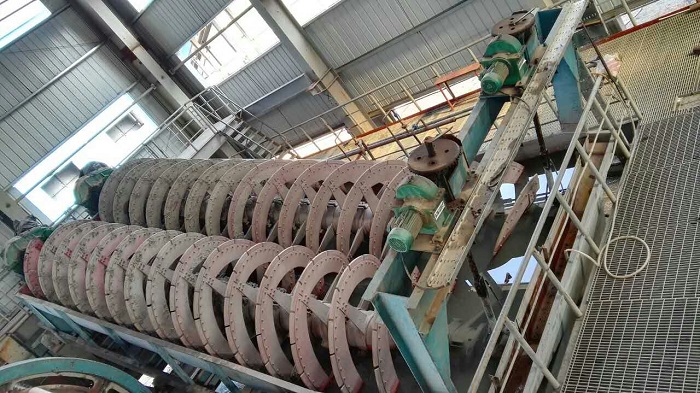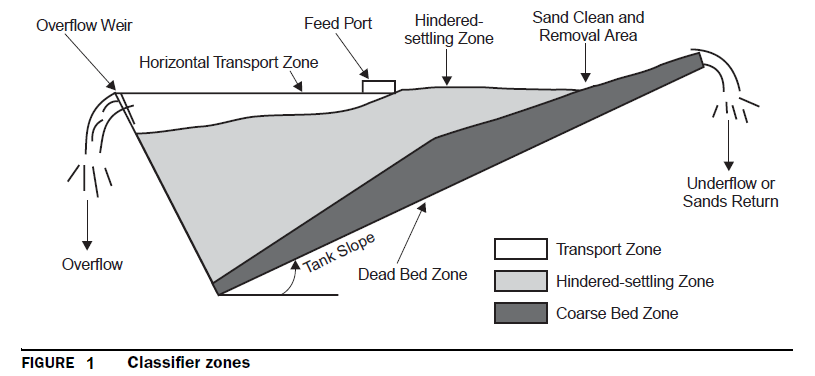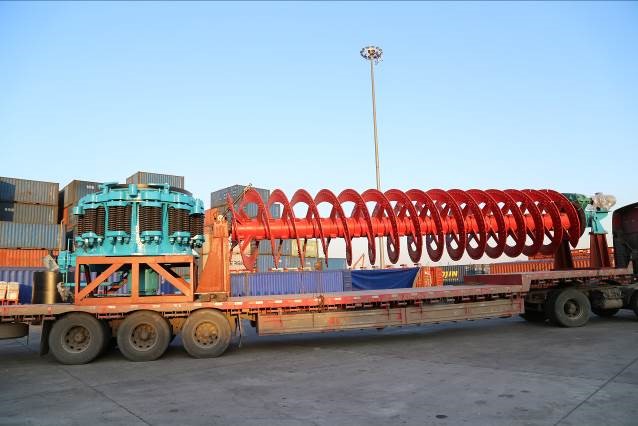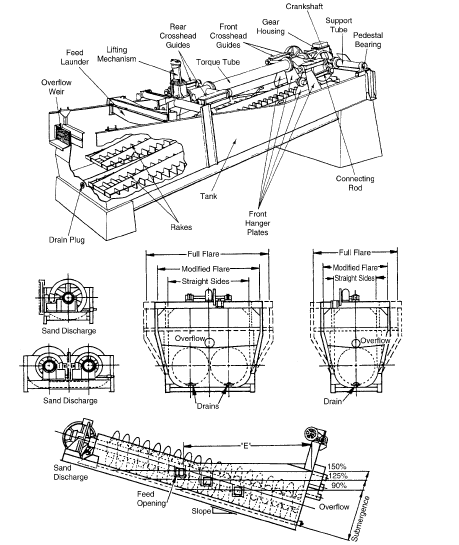As a important separation equipment in concentrator, Spiral or rake classifiers are semi rectangular tanks with parallel sides (sides may flare somewhat toward the overflow end) and a sloped bottom.

Inside the tank, a rake or a spiral mechanism conveys coarse material upward to a sands return chute and back to ball mill. Figure 1 shows schematics of a rake classifier and the more modern spiral classifier.

General Characteristics of classifier.
Take L to be the length of the classifier. Feed enters at a point that is about 0.6 L (high weir type) or 0.5 L (overflow end of spiral submerged) or 0.3 L (low weir type) from the overflow weir (the overflow weir is a movable baffle plate at the overflow end, the height of which can be adjusted to control pool area). Spirals are preferred to rakes because spirals cost less to maintain.
Either rakes or spirals move coarse sand out of the tank. Rakes employ a repetitive rectangular trajectory whose long dimension is parallel to the bottom. Rakes in their down-and-forward position move parallel to the bottom, thereby dragging coarse solids up the slope. At a certain point, the blades lift and then reverse their direction of parallel motion while in the up position (up-and-reverse stroke). Again, at a certain point, the blades drop back to the bottom and begin their down-and-forward stroke to push sand up the slope. A rake may complete up to 30 down-and-forward strokes per minute, depending on the classifier's areal efficiency (the ratio of effective pool area to actual pool area).

The spiral has a pitch of 50%–75% of its diameter, although 50% is recommended, where pitch is the distance between the helix flights (the spiral arms). The axis of the spiral is parallel to the bottom and rotates at speeds of 2–10 rpm in a direction that conveys sand up-slope. In “duplex” (twin spirals) versions of the classifier (Figure 1), weir height can be automatically adjusted.
Classifier Zones
The diagram in Figure 2 shows general zones that exist in horizontal classifiers
Separation size and overflow capacity depend on several design and operating variables that influence settling in the classifier pool, which contains zones as shown in Figure 2. In the horizontal flow transport zone, which is relatively dilute, the bulk of the water and the lighter particles are transferred to the overflow. Heaviest particles work their way down through the hindered-settling zone and enter the sands removal zone to be conveyed up-slope by the mechanism (e.g., spirals). A dead bed zone accumulates more or less permanently between the outer edge of the spirals and the tank bottom.

Fig2. Rake and spiral classifiers
Interparticle transfer between zones is always taking place. The top of the hindered-settling zone has a lower pulp density than the bottom of the zone. Spiral motion agitates the hindered-settling zone so it behaves somewhat like a heavy-medium suspension. Particles intermediate between light and heavy are sensitive to the suspension density and viscosity of this zone. Water is often added with feed slurry by a separate line controlled by an operator. Sprays are employed to clean the mechanism.
Variables That Influence Separation Size and Capacity
Design variables of importance include degree of end flare, number of spiral flights (or, for rakes, rake blades), point of feed entry, tank slope, and spiral (or rake) speed; operating variables are feed size distribution, feed rate, mineralogical composition, weir height, and total water added to classifier.